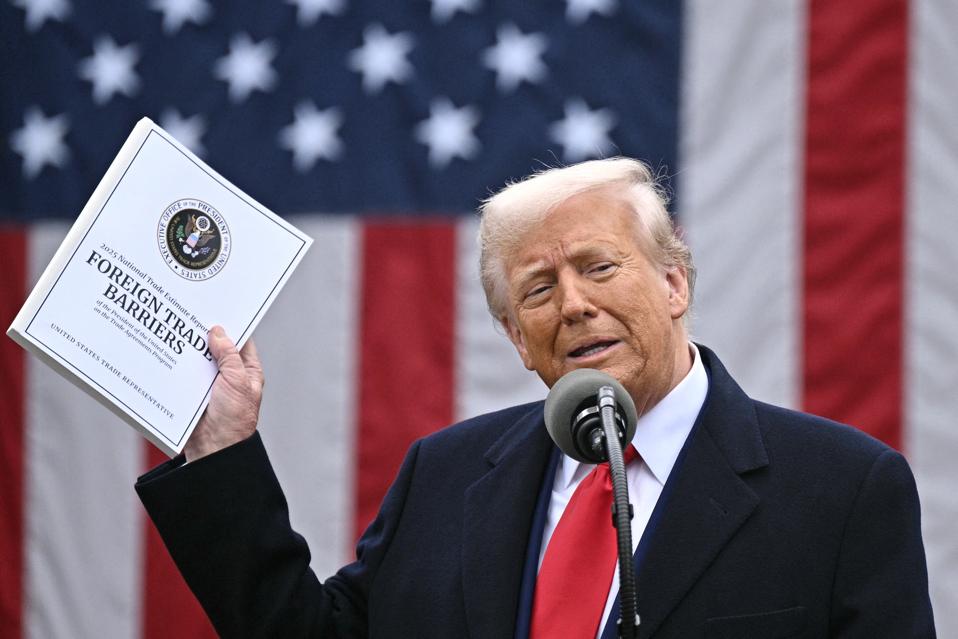Recent headlines about short term swings in tariffs and stock market volatility make good journalistic copy, but they ignore a much bigger story. Possible deregulatory improvements and reductions in international trade barriers have the potential to usher in a period of faster economic growth that could benefit all Americans.
Two recent initiatives, instituted by President Trump, could serve as the catalysts for pro-growth change: a 90 day period of trade negotiations and an April 9 Executive Order on Reducing Anti-Competitive Regulatory Barriers.
Trade Negotiations
On April 9, 2025, President Trump announced a 90 day pause on new tariffs (above a basis 10 percent tariff rate) for most nations except China, to allow time for country-specific trade negotiations. Secretary of the Treasury Scott Bessent indicated that the negotiations could touch on “a whole box of things we’ve got to overcome: tariffs, non-tariff barriers, trade barriers, currency manipulation and subsidization of labor and facilities.”
The Administration’s emphasis on non-tariff barriers is wise. On March 31, 2025, the U.S. Trade Representative issued its annual National Trade Estimate Report on Foreign Trade Barriers. That Report highlights a wide panoply of harmful foreign practices “that restrict, prevent, or impede the international exchange of goods and services”.
The Report (emphasis added) explains that those practices share in common a distortion of competition:
“Trade barriers . . . may be broadly defined as government laws, regulations, policies, or practices – including non-market policies and practices – that distort or undermine fair competition. These include measures that protect domestic goods and services from foreign competition, artificially stimulate exports of particular domestic goods and services, or fail to provide adequate and effective protection of intellectual property rights. Non-market policies and practices, such as targeting of industrial sectors for dominance, non-market excess capacity, and distorting activities of state-owned or state-sponsored firms, may create economic and national security risks and undermine U.S. competitiveness.”
Essentially all U.S. trading partners impose at least some of these “anticompetitive market distortions.” China is by far the leading culprit, but the European Union and its member states are big distorters as well.
These ACMDs impose great harm not only on the distorting nation’s trading partners, but on that nation’s domestic consumers and disfavored companies as well. Often ACMDs arise from special interest lobbying of powerful domestic business interests that seek to obtain or retain monopoly power. In the case of China, ACMDs may also reflect a national industrial strategy to achieve global economic dominance in key sectors.
The Growth Commission (an independent organization of international economists that studies economic growth) has studied these “anti-competitive market distortions.” I
In its April 15, 2025 Report, the Commission describes its econometric model that estimates per capita gross national product losses stemming from ACMDs, including the harmful impact on the U.S. economy. The scale of diminshed national income is huge, dwarfing that of tariffs.
The Growth Commission Report recommends that U.S. trade negotiations focus on American tariffs “as market-correcting mechanisms designed to: (1) penalize distortive behavior; (2) create reform incentives for offending countries; and (3) level the playing field for U.S. producers.” Specifically, U.S. “ACMD tariffs would phase down as offending countries” reduce their ACMDs, “bringing transparency and accountability to a volatile trade environment.”
Trump Executive Order on Reducing Anti-Competitive Regulatory Barriers
Nevertheless, foreign ACMDs, as the product of foreign special interest behavior and government policy, may be hard to dislodge.
Fortunately, however, President Trump gave U.S. trade negotiators a big juicy carrot to offer their foreign counterparts. That carrot is due to the fact that, unfortunately, the U.S. has ACMDs as well.
The President’s April 9 Order on Reducing Anti-Competitive Regulatory Barriers takes direct aim at American ACMDs. It orders all federal executive (including independent) agencies to create lists cataloguing all of their regulations that qualify as ACMDs within 70 days. The Federal Trade Commission and the Justice Department, consulting with the White House and agencies, will then have 90 days to present a master list of regulations recommended for repeal or modification. After some additional consultations, OMB will publish a final compilation of regulatory “rescissions and modifications.”
Of course, there will be legal challenges, particularly by special interest groups that would lose anticompetitive benefits. But recent Supreme Court decisions would give the Trump Administration a fair shot at winning many if not all of the judicial battles.
By emphasizing the Order’s dramatic and unprecedented challenge to large numbers of existing regulations (the carrot), American negotiators could gain major leverage. They could push for a “win-win” result raising per capita GDP in both the U.S. and its negotiating partners, through a mutual agreement to dismantle key ACMDs. The U.S. could point out that foreign traders and investors would benefit directly from the reduction of anticompetitive American regulatory barriers.
What’s Next
Getting rid of ACMDs is hard politically. But the major benefits of significant ACMD reductions are well worth pursuing.
At a press conference around the 2018 G7 Summit in Ottawa, President Trump made a statement that implicitly supports the mutual dismantling of ACMDs:
“You want no barriers. And you want no subsidies. Because you have some cases where countries are subsidizing industries and that’s not fair.”
Hopefully an American trade negotiating strategy that keeps these words firmly in mind, now and in the future, will yield some fruit.

